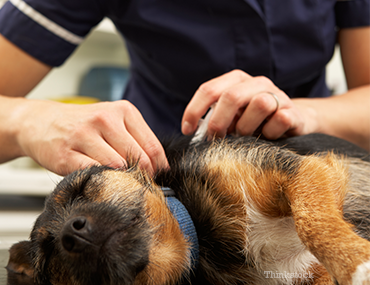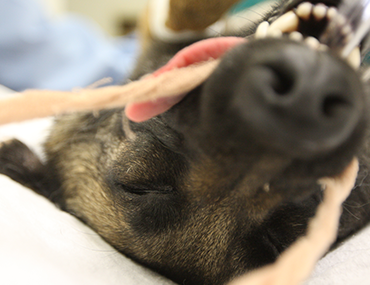Kelly Serfas, a Certified Veterinary Technician in Bethlehem, PA, contributed to this article.
Anesthesia can be scary. In addition to understanding the particulars of anesthesia, make sure you understand the real risks for your particular pet by asking following questions of your vet, general practitioner or specialist. Yes, it will take a little bit of time. It may even sound annoying or picky at times… But it is well worth it to ensure the well being of your beloved pet.
1. What are the risks of anesthesia for my pet?
Some pets are ideal candidates for anesthesia, like a healthy 6 month old kitten who needs to be neutered. Others can present significant risks because of a variety of health conditions: heart murmur, liver disease, infection etc. If your pet has a flat face (brachycephalic breeds such as a Himalayan cat or a Bulldog), there is an increased risk of complications before, during and after anesthesia. Therefore, special precautions should be taken at every step - which you should discuss with your vet. Chubby patients are at a higher risk for anesthesia because they don't breathe well.
2. Will my pet have an IV catheter and IV fluids?
The duration and invasiveness of the procedure will usually determine if your vet will place an IV catheter and give IV fluids. For minor procedures (radiographs, bandage placement, nail trim), it may not be necessary. For others (most surgeries, dental procedures), it is very beneficial to place an IV catheter and give IV fluids. The catheter helps administering anesthesia drugs and pain medications and the IV fluids help maintain proper organ function, starting with the kidneys.
3. Who will monitor my pet?
In a perfect world, all patients under anesthesia would be monitored by a veterinary nurse or technician who has been specifically trained to perform and adjust anesthesia. Even better, this person should ideally stay with your pet during and after anesthesia at all times.

4. How will my pet be monitored?
These days, pets can be monitored almost as well as people. We can track heart beats, EKG, blood pressure, oxygen levels, CO2 levels, temperature, respiration rates and more. The more we know about what's going on inside a patient, the safer the anesthesia is. Now different clinics offer different levels of monitoring. Most clinics these days can monitor oxygen levels. However, few can track CO2, even though it’s a very important piece of information. An experienced technician will also rely on his or her senses, including listening, touching, and observing the patient..
5. Who will recover my pet?
Waking up from anesthesia is half the battle. More pets actually get in trouble after anesthesia than during anesthesia. Therefore, it is very important to continue monitoring patients very closely after they wake up.
6. What is done to make sure my pet is safe to go under anesthesia?
Several things can be done to decrease the risks of anesthesia. Most vets will recommend blood work to make sure your pet is healthy. Even if we find liver or kidney disease, we can perform safe anesthesia. We might, however, need to tweak the anesthesia protocol to decrease the dose of certain drugs or eliminate them altogether. Depending on your particular pet’s health, we may also recommend an EKG, blood pressure testing, chest X-rays or an ultrasound.
7. What happens during anesthesia?
Typically, a tranquilizer is given first. This will make your pet drowsy. We then often place an IV catheter. About 20 to 30 minutes later, anesthesia drugs are given IV. A plastic tube is then placed in the wind pipe or trachea. This allows delivery of 98% pure oxygen and 2% anesthesia gas on average. Anesthesia is then maintained with gas. At the end of anesthesia, the gas is turned off and your pet is kept on 100% oxygen. When your pet starts to wake up, the tube is pulled out of the trachea and normal breathing starts again.
8. How long will my pet take to recover?
This depends on many factors, including health status, involvement of the procedure, duration of anesthesia, drugs given, breed, age and body temperature. In other words, you would expect a healthy, crazy, happy 6 month old lab to recover very quickly from a spay. You also would expect a 14 year old diabetic, hypothyroid toy poodle to take longer to recover from a two hour surgery.
9. Should I leave a blanket or piece of clothing with my scent on it?
You may leave a blanket or piece of clothing at most hospitals… as long as you understand that they may get lost. Why? Not because we’re careless, but because if your pet soils your item, it will be washed and dried.
Many hospitals have staggering amounts of laundry to go through every day because their caring staff always makes sure pets have clean blankets and towels at all times. In other words, your blanket may be buried (not quite lost) in a mountain of laundry. If you are really emotionally attached to a specific blanket or towel, please keep it at home. We will provide whatever your pet needs.
 10. Why do I need to sign an anesthesia/surgery consent form?
10. Why do I need to sign an anesthesia/surgery consent form?
When you sign the anesthesia and surgery consent form, you acknowledge that you understand the diagnosis, the possible risks and the likely outcome of the procedure you have discussed with your vet. The consent form is both a medical and legal document. Therefore, it is important that you truly understand what will and might happen during your pet’s care.
Clearly, there are always risks with anesthesia, no matter how careful we are. Make sure you understand those risks. An honest, open discussion should reassure you that your pet in in great hands and that everything will be done to return your pet home at soon as possible.
If you have any questions or concerns, you should always visit or call your veterinarian – they are your best resource to ensure the health and well-being of your pets.
![]()
